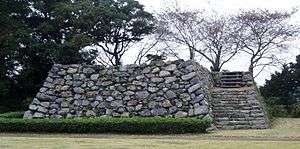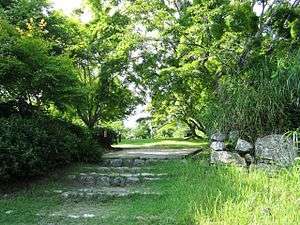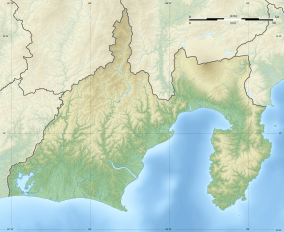Futamata Castle
Futamata Castle (二俣城, Futamata-jō) is a Japanese castle located in Toyoda county of Tōtōmi Province, in what is now part of Tenryū-ku in the city of Hamamatsu, Shizuoka Prefecture, Japan. It was built in the Sengoku period and is noted as the site of the death of Tokugawa Ieyasu's son Matsudaira Nobuyasu in 1579. In 2018, the site was recognized as a National Historic Site by the Japanese government together with adjacent Tobayama Castle (鳥羽山城, Tobayama-jō).[1]
| Futamata Castle | |
|---|---|
二俣城 | |
| Tenryū-ku, Hamamatsu, Shizuoka prefecture, Japan | |
 Ruins of Futamata Castle | |
 Tobayama Castle Site | |
 Futamata Castle  Futamata Castle | |
| Coordinates | 34°51′43.29″N 137°48′32.16″E |
| Type | Yamajiro-style Japanese castle |
| Site information | |
| Open to the public | yes |
| Condition | ruins |
| Site history | |
| Built | 1503 |
| Built by | Imagawa clan |
| In use | Sengoku period |
| Demolished | 1600 |
Futamata Castle
Futamata Castle is located on a long and narrow hill at the confluence of the Tenryū River with the smaller Futamata River. Surrounded its three directions by rivers, the site was a natural fortification, but was also located in a strategic location guarding the entry into southern Shinano Province.
Futamata castle was originally built by the Imagawa clan in 1503 and was assigned to their vassals, the Matsui clan. In 1560, Imagawa Yoshimoto was defeated and killed at the Battle of Okehazama as was the castellan of Futamata, Matsui Munenobu (1515–1560). HIs son, Matsui Munetsune held the castle for Yoshimoto's son, Imagawa Ujizane, but the weakened clans were unable to withstand a combined attack from their former ally Takeda Shingen and Tokugawa Ieyasu in 1569. Ieyasu occupied both Hamamatsu Castle and Futamata Castle, and assigned Futamata to his ally, Udono Ujinaga. However, fearing that Udono was lukewarm towards the Takeda clan, Ieyasu soon replaced him with a fudai vassal, Nakane Masateru.
In October 1572, Takeda Shingen launched a massive invasion and overran Tōtōmi Province, capturing Futamata after a siege of one month. The Takeda forces defeated the Tokugawa clan at the Battle of Mikatagahara; however, due to the sudden death of Takeda Shigen in 1573, the invasion collapsed, and the Takeda armies retreated back to Kai Province. Over the next few years, his successor, Takeda Katsuyori contested Tokugawa Ieyasu for control of Tōtōmi Province, but was defeated at the Battle of Nagashino by a coalition of Tokugawa Ieyasu and Oda Nobunaga. Futamata Castle remained under the control of the Takeda clan after the battle, and after a siege over six months, finally surrendered to the Tokugawa at the end of 1575.
Futamata Castle was entrusted to Ieyasu's general Ōkubo Tadayo. In 1579, Ieyasu's son and heir, Matsudaira Nobuyasu, was ordered to relocate to Futamata Castle from Hamamatsu, where after a couple of months he was ordered to commit seppuku, His mother (and Ieyasu's official wife), Lady Tsukiyama was executed as well. The official charges were that of conspiracy with the Takeda clan, but the precise reasons for this event are not entirely clear. Oda Nobunaga feared that the talented Matsudaira Nobuyasu posed a threat to his own son, Oda Nobutada, and Lady Tsukiyama was from the Imagawa clan and also had connection with the Takeda.
Nobunaga's successor, Toyotomi Hideyoshi ordered that the Tokugawa relocate to the Kanto region in 1590, and gave both Futana and Hamamatsu's castles to his own general, Horio Yoshiharu. Yoshiharu reformed the castle with stone walls and a main keep, but was subsequently transferred to Izumo Province in 1600, at which time the castle was abandoned. In 1896, a shinto shrine dedicated to the war dead of the First Sino-Japanese War was constructed on the site of the northern kuruwa enclosure. It was subsequently rededicated also to the death of the Russo-Japanese War and the Pacific War.
Tobayama Castle
Tobayama Castle is located on the next hill from Futamata Castle, separated by the narrow Futamata River. It was originally built in 1572 by the Tokugawa forces laying siege to Futamata Castle, but was but later expanded and rebuilt by Horio Yoshiharu as a residential castle, as Futamata Castle had only limited space to build a large residence.
The inner bailey of Tobayama Castle is a 100-meter-square space surrounded by stone walls with a masugata (composite gate) guarded by large stones.
The two castles were operated as one by Horio Yoshiharu and Tobayama Castle was also abandoned in 1600.. Half broken stone walls remain at its inner bailey.
Notes
- "祝!国指定史跡誕生! 二俣城跡及び鳥羽山城跡" (in Japanese). Hamamtsu City home page.
References
- Schmorleitz, Morton S. (1974). Castles in Japan. Tokyo: Charles E. Tuttle Co. pp. 144–145. ISBN 0-8048-1102-4.
- Motoo, Hinago (1986). Japanese Castles. Tokyo: Kodansha. p. 200 pages. ISBN 0-87011-766-1.
- Mitchelhill, Jennifer (2004). Castles of the Samurai: Power and Beauty. Tokyo: Kodansha. p. 112 pages. ISBN 4-7700-2954-3.
- Turnbull, Stephen (2003). Japanese Castles 1540–1640. Osprey Publishing. p. 64 pages. ISBN 1-84176-429-9.